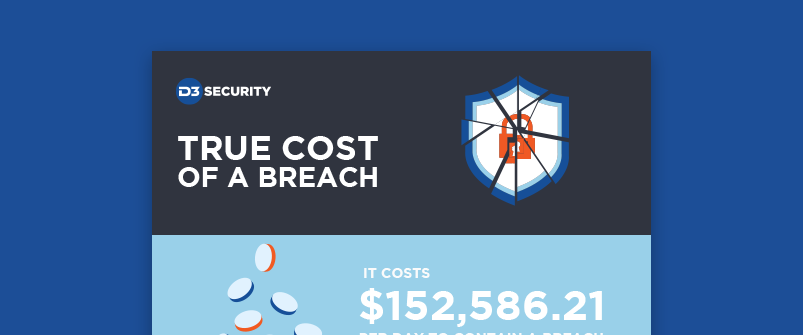

We all know that security breaches can cost companies millions in regulatory fines and lost business. Plus, investigation and remediation costs can run into the millions of dollars, especially for attacks perpetrated by well organized adversaries. In other words, the cumulative cost of a breach becomes its true cost.
To illustrate the full cost of a breach, we created an infographic that depicts its multiple components:

Time and Cost to Identify and Contain Security Breaches
It takes time to identify a security breach. According to the Ponemon Institute’s annual Cost of Data Breach Study, the average time taken to identify a data breach was 191 days, with containment requiring, on average, an additional 58 days. And the longer it takes to identify and contain the breach, the higher the cost and risk of expensive litigation.
To calculate the financial impact of a security breach, researchers at Verizon developed a model based on the analysis of nearly 200 cyber-liability insurance claims. This model predicts the cost of a breach involving 10 million records will be between $2.1m and $5.2m but could go up to $73.9 million depending on the circumstances. This model also predicts that a breach involving 100 million records would cost between $5m and $15.6m and could potentially top out at $199 million. Even at the low range, the figures are substantial and represent significant financial and regulatory risk.
To illustrate the average costs of discovering and responding to a breach we have calculated the costs per day, hour and minute in the infographic. These costs are averages and can vary depending on several factors unique to each case. To reduce response times, and thus the cost of a breach, companies need to implement an effective Incident Response System.
Post-Breach Expenses
Once a breach has been detected, security teams need to take several actions to contain, mitigate and prevent the breach from recurring. If your organization lacks an Incident Response System to manage and automate post breach actions, simple manual tasks and potential human error could wind up costing thousands of dollars, or much more, depending on the incident’s severity. For companies that want to speed up their triage, response and forensics, having a “centralized nerve center” like D3 is essential.
The most severe and long-lasting consequence of a breach come in the form of damages to the brand and its reputation. A 2015 survey found that 64% of consumers said they were unlikely to shop or do business again with a company that experienced a breach in which financial information was stolen.
While direct monetary costs are not the only consequence of a breach, companies are increasingly purchasing cyber security insurance to mitigate and write off some potential losses. However, even insurers have recognized the value of an incident response system; insurance rates are often significantly lower for organizations with an established and consistent incident response process.
How Can D3 Help?
D3 Security’s Incident Response Platform provides a full-lifecycle remediation solution and a single tool to determine the root action of any incident. This includes a playbook library and orchestration engine that guides responders at each step from detection to resolution. These tools enable security teams to respond faster and drastically reduce the cost of a breach.
Click on the button below to schedule a demo to see how D3 can help your organization prepare for, mitigate and respond to security breaches.

